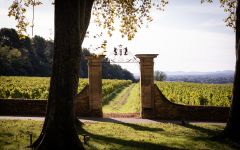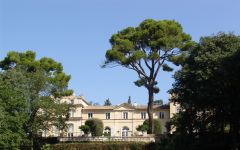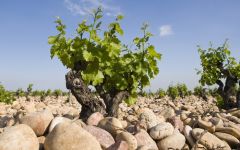Chateau La Nerthe Chateauneuf-du-Pape Cuvee des Cadettes 2012
-
Wine
Spectator -
Robert
Parker -
Wilfred
Wong



Product Details
Your Rating
Somm Note
Winemaker Notes
Blend: 39% Syrah, 37% Grenache, and 22% Mourvèdre.
Professional Ratings
-
Wine Spectator
Rather ripe, with alluring warmed raspberry coulis, plum sauce and blackberry paste flavors, threaded with a licorice snap note and backed by warm ganache and Turkish coffee accents. Not shy in style, but has the freshness to stay balanced. Best from 2017 through 2024.
-
Robert Parker's Wine Advocate
Also slightly more mid-weight than I remember, yet still more than outstanding, the 2012 Chateauneuf du Pape Cuvee des Cadettes (39% Syrah, 37% Grenache, 22% Mourvedre and the rest assorted varieties, aged in new French oak) has classy notes of cassis, toast, vanilla bean and roasted meats. Possessing fabulous purity, medium to full-bodied richness and moderate overall depth and concentration, it can be enjoyed anytime over the coming decade. While this needs more flesh, it should still evolve gracefully on its overall balance.
-
Wilfred Wong of Wine.com
The 2012 Château La Nerthe Châteauneuf-du-Pape Cuvée des Cadettes is a powerful wine. From start to finish, this wine exhibits loads of berries, new oak, and sweet earth. The wine's richness makes it a superb choice with grilled meats. Needs time. (Tasted: September 13, 2016, San Francisco, CA)
Other Vintages
2015-
Tasting
Panel -
Wine
Spectator -
Robert
Parker -
Jeb
Dunnuck -
Wine &
Spirits
-
Robert
Parker -
Wine
Spectator -
Wine
Enthusiast
-
Wine
Spectator -
Robert
Parker
-
Wine
Spectator -
Robert
Parker
-
Wine
Spectator -
Robert
Parker
-
Wine
Spectator -
Robert
Parker
-
Wine
Spectator -
Robert
Parker
-
Robert
Parker -
Wine
Spectator









Archives affirm Chateau La Nerthe’s existence as early as 1560, while suggesting an even more distant past dating to the dawn of the region’s wine culture in the 12th century making it one of Chateauneuf’s oldest estates. Located in the heart of the Chateauneuf-du-Pape AOC region of southern France not far from Avignon, the 225 acres of Chateau La Nerthe vineyards are located in a single block around the Chateau and have been certified Organic since 1998. The terroir is very typical for the region: vineyards runs along a slope, at the top of which the vines dig their roots into soils of sandy-clay, on the surface there is a layer of the famous galettes, large, round, well-worn stones that originated in the Alps, having been carried down to the Rhône by the glaciers of previous ice ages. The further down the slope of the vineyard you travel, the more these stones dominate. All 14 of the permitted primary varietals are planted-Grenache dominates 62% of vineyards and the vines average over 40 years old. Chateau La Nerthe is the prime expression of Chateauneuf-du-Pape.

With bold fruit flavors and accents of sweet spice, Grenache, Syrah and Mourvèdre form the base of the classic Rhône Red Blend, while Carignan, Cinsault and Counoise often come in to play. Though they originated from France’s southern Rhône Valley, with some creative interpretation, Rhône blends have also become popular in other countries. Somm Secret—Putting their own local spin on the Rhône Red Blend, those from Priorat often include Merlot and Cabernet Sauvignon. In California, it is not uncommon to see Petite Sirah make an appearance.

Famous for its full-bodied, seductive and spicy reds with flavor and aroma characteristics reminiscent of black cherry, baked raspberry, garrigue, olive tapenade, lavender and baking spice, Châteauneuf-du-Pape is the leading sub-appellation of the southern Rhône River Valley. Large pebbles resembling river rocks, called "galets" in French, dominate most of the terrain. The stones hold heat and reflect it back up to the low-lying gobelet-trained vines. Though the galets are typical, they are not prominent in every vineyard. Chateau Rayas is the most obvious deviation with very sandy soil.
According to law, eighteen grape varieties are allowed in Châteauneuf-du-Pape and most wines are blends of some mix of these. For reds, Grenache is the star player with Mourvedre and Syrah coming typically second. Others used include Cinsault, Counoise and occasionally Muscardin, Vaccarèse, Picquepoul Noir and Terret Noir.
Only about 6-7% of wine from Châteauneuf-du-Pape is white wine. Blends and single-varietal bottlings are typically based on the soft and floral Grenache Blanc but Clairette, Bourboulenc and Roussanne are grown with some significance.
The wine of Chateauneuf-du-Pape takes its name from the relocation of the papal court to Avignon. The lore says that after moving in 1309, Pope Clément V (after whom Chateau Pape-Clément in Pessac-Léognan is named) ordered that vines were planted. But it was actually his successor, John XXII, who established the vineyards. The name however, Chateauneuf-du-Pape, translated as "the pope's new castle," didn’t really stick until the 19th century.
